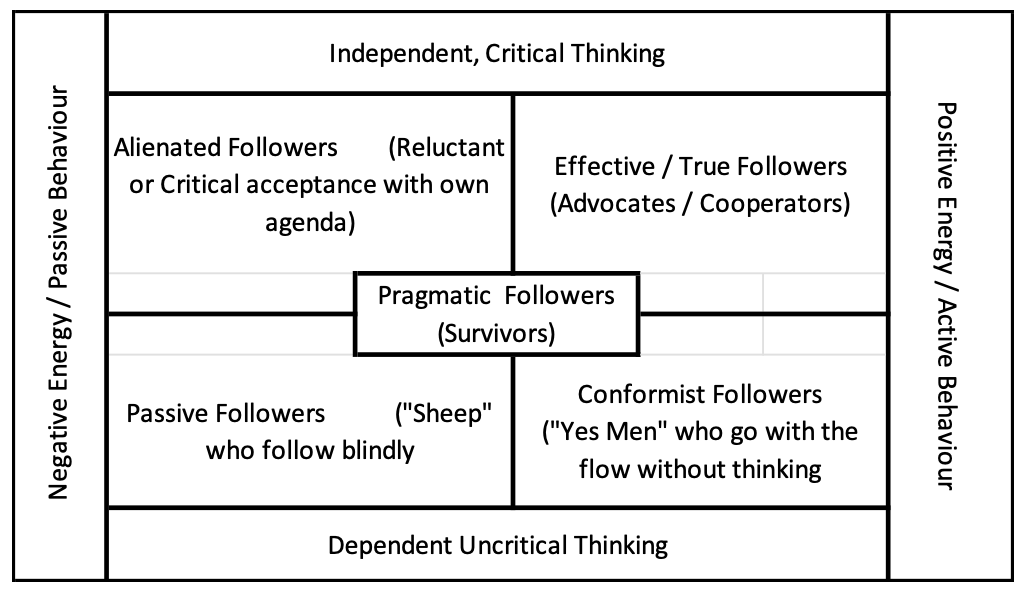 There are thousands of studies on leadership. We have a multitude of postings on social media as well as a myriad of academic tombs, dissertations, and theses as to what leadership is and sometimes what it isn’t. People strive to understand leadership be it inspirational, transformational, situational, charismatic, transactional, autocratic, democratic, strong, or weak…the qualifiers go on.
There are thousands of studies on leadership. We have a multitude of postings on social media as well as a myriad of academic tombs, dissertations, and theses as to what leadership is and sometimes what it isn’t. People strive to understand leadership be it inspirational, transformational, situational, charismatic, transactional, autocratic, democratic, strong, or weak…the qualifiers go on.
No matter what style or application of leadership is practiced one thing that every leader needs is a following, or followers. A leader without followers is said to be ‘delusional’. Some leaders may delude their followers by leading them up some garden path or have them dance a merry dance along the way but that is a problem for the followers. If a far from satisfactory outcome is reached, then rather than blaming ‘leadership’ which is a common trend, perhaps we should also be looking at ‘followership’.
A quick search of the internet shows that there are billions of articles on leadership and trifling millions regarding followership. This circa 1,000-fold difference potentially demonstrates Benford’s Law of Controversy where passion is inversely proportional to the amount of real information available. People and organisations understand that leadership is essential and are passionate about how their ‘leadership’ can be enhanced. The disproportionate amount of information available would imply that ‘followership’ is understood, but is it?
Leadership
Leadership has been described as an ability to influence, guide, persuade, inspire, and direct people to follow a certain course of action. Leadership comes naturally to some, and it’s surmised that 10% of the population are born leaders and another 20% can be trained effectively. This is akin to the all too familiar Pareto Effect with a 20/80 split of leaders to followers.
Leadership can be most significant when it’s absent. Unless somebody steps into the breach then standards and behaviour of any team will decline unless an organisational culture or subculture is maintained. If followers don’t ‘follow,’ and in the absence of a leader then satisfactory underperformance can easily prevail. Doing just enough to ‘get-by’ and ‘heads down’ can quickly become the order of the day.; why bust a gut when there’s no one pushing!
Leadership is based on the triad of knowledge, trust, and power. It’s also a function of the leader, the followers, their organisational structure and how they are managed and manage themselves. A considerable proportion of leadership is related to the people being led and how they practice followership. This ‘followership’ depends on abilities, attitudes, and personalities.
Personalities
The Myers Briggs Type Indicator (MBTI) defines 16 personality types. This is based on four ranges of personality aspects; Thinking vs Feeling, Judging against Perceiving, Extroversion vs Introversion; and Sensing over iNtuition. This relates to how individuals process information, how the make decisions, and their approach to judgement as shown below:
Some personalities are more suited to lead than others and, consequently they are drawn to leadership positions. Personalities aside, leadership and followership are based on the individuals ‘behaviour as well as their attitude which, semantically, is about how people think.
A person may have attributes and ability but if their attitude is unsuited to the overall performance of a team then their behaviour will be such that there will be negative consequences. Leaders may use different techniques to inspire and encourage people but sometimes the square peg won’t fit the round hole. As with a garden that has gone wild, dead wood and undergrowth need to be removed so followership may be cultivated, sharp catching edges may have to be removed.
Followership
Followership is the relationship between individuals and the leader, their interaction, and the consequent behaviour. Leaders too need to practice followership. After all everybody is ultimately accountable to somebody and follow something: even if it’s merely a belief. While leadership has been studied and written about for millennia, studies of ‘followership’ are in their relative infancy.
Dr Robert E Kelley has formulated a two-by-two matrix to categorise how followers may be classified. This is based upon behavior, be it active or passive, and the ability for independent critical thinking. He also ascertained that 80% of an organisation’s outcomes (+ve or -ve) depend on followers (the Pareto effect again!) and five types of followers can be recognised:
Based on Pareto, and a degree of cynicism, and unless your team is exclusive and specifically picked and trained for the work at hand, we may well find that only 20% will be true followers. Unfortunately, this leaves the prospect that 40% will be pragmatic followers and up to 30% of people will be sheep, yes-men who agree without thinking, and those who have their own agenda.
Conclusion (?)
Leaders and followers have been around since the beginning of time and, despite millennia of study, mankind still hasn’t worked out how or why this relationship works. Leadership is blamed for many things but ultimately followers also have a responsibility.
Leaders need to follow their followers. They need to monitor and control, consequently followership is a two-way street. Leaders need to follow to see if outcomes are acceptable!
Leadership, as Churchill said, is what leaders do. Effective leaders, no matter what their style, need to be supported by effective followers. Perhaps the combination of leadership and followership is the third side of the coin represented by leaders on one face and followers on the other rather than a dichotomy?
Bio:
Malcolm Peart is an UK Chartered Engineer & Chartered Geologist with over thirty-five years’ international experience in multicultural environments on large multidisciplinary infrastructure projects including rail, metro, hydro, airports, tunnels, roads and bridges. Skills include project management, contract administration & procurement, and design & construction management skills as Client, Consultant, and Contractor.

